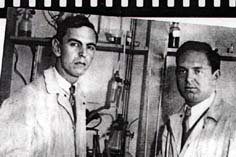
|

|
Jewish World Review / March 8, 1998 / 10 Adar, 5758
Herb Geduld
FLASH! How two nice Jewish musicians created color film
TWO OF THE MOST remarkable, improbable and least-known inventors of the 20th century, were a pair of Jewish-American musicians --- Leopold Mannes and Leopold Godowsky, Jr., affectionately nicknamed by their colleagues, "Man" and "G-d."
Although they were both highly skilled, professional, classical musicians, and scions of well-known performing families, their inventions had nothing to do with music. Mannes and Godowsky were the primary inventors of color photography as we know it today. The original Kodachrome, Ektachrome, Kodacolor, and Ektacolor film processes were all products of their collective genius.
Their fascination with color photography began in 1917, when as teenagers. They went to see a movie titled, Our Navy, which was billed as a color motion picture. It was a murky, dull film in unnatural tones, and the boys, avid amateur photographers, felt that there must be a better color process. Using their high school physics lab, they built a camera and projection device with three paired lenses and filters, one for each of the primary color. This system reproduced results impressive enough to get them a patent while still in high school. It was not, however, a marketable photographic process.
Godowsky went to college at UCLA and became a violinist with the Los Angeles and the San Francisco Symphony Orchestras. Mannes continued to play professional piano while studying physics at Harvard. Although a continent apart, the boys continued to collaborate on ideas for improving color photography. By 1922, Godowsky had given up his orchestra jobs in California and moved back to New York City where he and Mannes worked as musicians. They avidly experimented with color photography during their spare time, much to the discomfort of their parents, whose kitchens and bathrooms were converted into laboratories and darkrooms.
While on his way to perform in Europe in late 1922, Mannes made the chance acquaintance of a senior partner in the investment firm of Kuhn, Loeb and Co. and enthralled him with his enthusiastic prospects for color photography. Some months later, much to the surprise of Mannes and Godowsky, Kuhn-Loeb sent one of their junior associates, Lewis L. Strauss (30 years later to become chairman of the Atomic Energy Commission) to the Mannes apartment to view the progress on their color process.
A Charlie Chaplin-like scenario ensued during which Mannes and Godowsky took turns playing Beethoven sonatas to their guest while they dashed back and forth to their darkooom/kitchen to develop their photographs
The process took an extraordinarily long time because of the cold temperature in the apartment. The final results were impressive enough, however, for Kuhn-Loeb to invest $20,000 in the process -- one of the most profitable investments the company ever made.
Mannes and Godowsky now built a proper laboratory and by 1924 had received additional patents on their work. By 1930, Eastman Kodak was so impressed with the results that they invited them to move to Rochester and take advantage of their vast research facilities.
By 1933, Mannes and Godowsky, with the help of the Kodak research staff, had come up with a marketable, three-color emulsion process for home color movies. And on April 15, 1935, the film, known as Kodachrome, was first put on sale. In the years that followed, Ektachrome, Ektacolor and Kodacolor processes were pefected.
Color photography, previously a laboratory curiosity, had become part of the everyday world, largely based on the chemical genius of these two Jewish-American

Jewish historian, cultural maven, and JWR contributor Herb Geduld lives in Cleveland.
2/16/98: Isachar Zacharie, Presidential Corn-cutter and confidant
2/3/98: When Monticello had a mezuzah